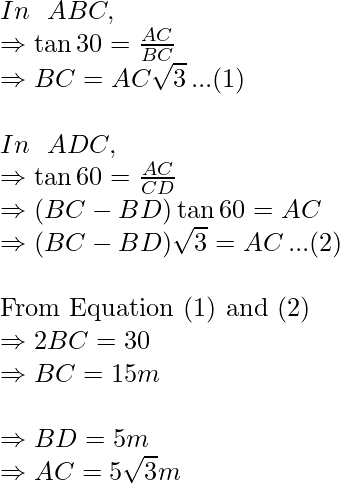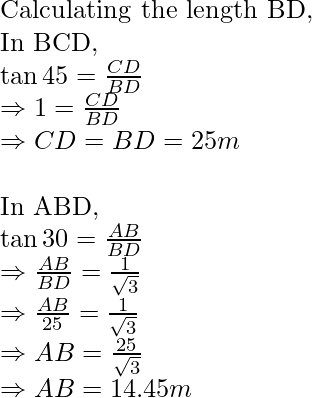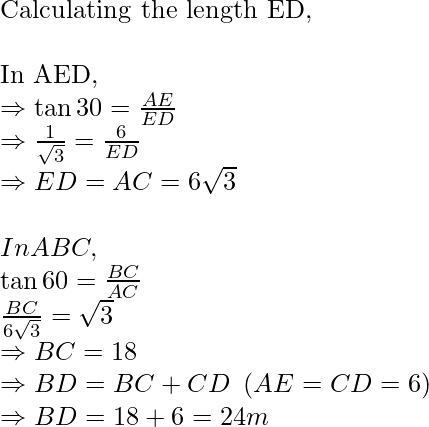CBSE Class 10 Maths Notes Chapter 9 Applications of Trigonometry are an excellent resource, for knowing all the concepts of a particular chapter in a crisp, and friendly manner. Our articles, help students learn in their language, with proper images, and solved examples for better understanding the concepts.
Chapter 9 of the NCERT Class 10 Maths textbook delves into the world of Applications of Trigonometry used in real life and covers various topics such as understanding the angle of elevation, angle of depression, and line of sight. These notes are designed to provide students with a comprehensive summary of the entire chapter and include all the essential topics, formulae, and concepts needed to succeed in their exams.
Need of Studying applications of Trigonometry
In Chapter 8, we have come across the introduction of trigonometry, but still thinking about its application in the real world. This chapter has been designed in a manner, such that, one could understand the role of basic trigonometry in real life. Trigonometry is highly useful in the real world because it provides a relationship between angles and distances. This chapter is limited to understanding the heights and distances, and their calculation, in the real world using trigonometry.
Heights and Distances
Heights here refers to the distance above the ground, and the distances are most probably the horizontal distances from the observer, to the building. Before starting our discussion on the questions part, we need to go through some new concepts used while solving questions.
Line of Sight
As, per the name, it is a straight line, which starts from your eye position, and ends at a target position. For example, a girl is standing in front of a building, and want to view the topmost point, of the building, then, the line joining her eye, and the top of the tower, is the line of sight.
Angle of Elevation
The angle of elevation is the angle between the line of sight, and the horizontal line passing through the eye position of the observer, and, the line of sight is always, above the horizontal one. For example, for plucking mangoes by throwing stones, requires a certain angle from the ground, which in turn is the angle of elevation, where line of sight, is the line passing your eye, and the mango.
Angle of Depression
The angle of depression is the angle between the line of sight, and the horizontal line passing through the eye position of the observer, and, the line of sight is always, below the horizontal one. For example, looking at the road, from a multi-story building.
What if Observer has a Height?
The above cases are valid if the height of the observer is 0. If the height of the observer is h, then, the line of sight will start from the height above h, as well as the horizontal line will be above h distance. The below image shows the horizontal distance, and the line of sight intersects, above height h.
Understanding the Problem Statements
The new concepts for this chapter have been covered above, now we are only left with the application part i.e. how to apply the concepts in the questions, and how to read the problem statements. The below steps show how to solve any problem in this chapter:
Step 1: Always, look upon the numbers given in the question, they might be angles or distances.
Step 2: Then, always draw a basic diagram of the given scenario. Marking the oberver, line of sight, angle of elevation, and angle of depression.
Step 3: Every problem in this chapter can be solved with two formulas i.e.


Step 4: Find the required distance or angle asked in the question.
Also, Read
Practice Questions for Some Application of Trigonometry
Question 1: A tree breaks due to a storm and the broken part bends so that the top of the tree touches the ground making an angle of 30° with it. The distance between the foot of the tree to the point where the top touches the ground is 8m. Find the remaining height of the tree.
Solution:
Step 1: The angle in the question is 30°, and the distance is 8m.
Step 2: On looking upon the statement, the diagram can be viewed as shown below. A triangle ABC, is formed, where, ∠BAC, is 30°, and AC is 8m. We, need to find the height i.e. BC.
Step 3: As, mentioned earlier only two formulas, are used for the entire chapter, i.e. of sine and tan. In this question, we need to find, the perpendicular distance from the given angle, so tan is used.


⇒ BC = 4.624.
Hence, the remaining height of the tree is 4.624m.
Question 2: A TV tower stands vertically on a bank of a canal. From a point on the other bank directly opposite the tower, the angle of elevation of the top of the tower is 60°. From another point 10m away from this point on the line joining this point to the foot of the tower, the angle of elevation of the top of the tower is 30°. Find the height of the tower and the width of the canal.
Solution:
Step 1: The angle in the question is 30°, 60° and the distance is 10m.
Step 2: On looking upon the statement, the diagram can be viewed as shown below. A triangle ABC, is formed, where, ∠ABC, is 30°, ∠ADC, is 60°and AC is 10m. We, need to find the height i.e. DC, and AC.
Step 3: As, mentioned earlier only two formulas, are used for the entire chapter, i.e. of sine and tan. In this question, we need to find, the perpendicular distance from the given angle, so tan is used.


Hence, the height of the tower is  m. and width of the canal is 5 m.
m. and width of the canal is 5 m.
Question 3: The angle of elevation of the top of a building from the foot of the tower is 30° and the angle of elevation of the top of the tower from the foot of the building is 45°. If the tower is 25 m high, find the height of the building.
Solution:
Step 1: The angle in the question is 30°, 45° and the height of the tower is 25m.
Step 2: On looking upon the statement, the diagram can be made as shown below. Two traingles ABD, and CBD are formed. CD = 25, ∠CBD = 45°, and ∠ADB = 30°, AB = ?.
Step 3: Calculate the length BD, then apply tan formula, to calculate AB.

Hence, the height of the building is 14.45m.
Question 4: From the top of a 6 m high building, the angle of elevation of the top of a cable tower is 60° and the angle of depression of its foot is 30°. Determine the height of the tower, from the foot.
Solution:
Step 1: The angle in the question is 60°, 30° and the height of the building is 6m.
Step 2: On looking upon the statement, the figure is made as shown below, where, ∠BAC = 60°, ∠DAC = 30°, AE = 6m, BD = ?.
Step 3: Calculate the length ED, then apply tan formula, to calculate BD.

Hence, the height of the tower from the foot is 24m.
FAQs on NCERT Notes for Class 10 Maths Chapter 9 Some Applications of Trigonometry
Q1: What is Trigonometry?
Answer:
A branch of mathematics, which deals with the angles, and the distance calculations. Trigonometry forms the basis of calculus, which in turn is the base of our modern science.
Q2: Is the line of sight always point towards the top of a tower, if standing on the ground?
Answer:
No, line of sight can point towards at any point on the tower, depending on the angle of elevation made, with the observer.
Q3: Are the Angle of elevation and the Angle of Depression the same?
Answer:
By definition, angles of elevation is not equal to the angle of depression, as, in angle of elevation, the line of sight is always above then, the horizontal line of the observer, while in angle of depression, line of sight is always below, the horizontal line of observer. Angle of elevation is made when observer is at a lower point, and looking at a higher altitude point, and angle of depression is made when observe is at a higher position, then the target position.
Q4: What are the applications of Trigonometry?
Answer:
At this stage, many students believe that trigonometry has no use case in real world, but that’s a wrong narrative.The following are the applications of Trigonometry:
- Trigonometry forms the basis of the modern mathematics, which in turn proves the laws of physics.
- Surveying is a good application of trigonometry. Have, you ever thought how the area of irregular grounds, which have no specified shape, is calculated, trigonometry, proves to be the life saver in it. We, simply divide an entire area, into small multiple triangles, and using trigonometry, by angle, and distance analysis, we calculate the area of a ground. Also, area of India is also calculated by this method only.
- Modern science, cannot be imagined without trigonometry. As, atoms, nucleus, bosons, cannot be seen by naked eye, we have only maths to understand them,which uses trigonometry.
Like Article
Suggest improvement
Share your thoughts in the comments
Please Login to comment...